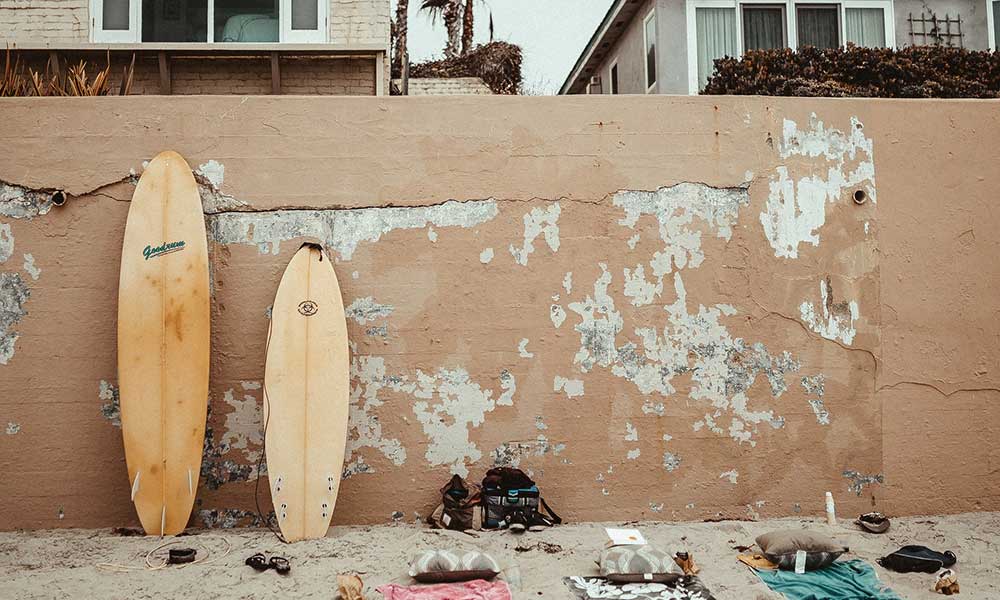A well-maintained surfboard will last for years, but if it’s not stored properly or is banged and knocked by rocks, wipeouts, and transportation catastrophes, it could reach the end of its life in a matter of months.
Surfboards yellow because of sun damage, AKA: UV radiation. The yellow you see is from the glass and/or foam that has turned yellow. There is nothing necessarily wrong with a yellowed surfboards as long as the surfboard is free of other damage like dings and delamination.
As soon as your surfboard cracks, chips, or suffers from delamination or yellowing, it’s important to fix the issues before they develop into something much worse and destroy your surfboard.
With that said, here are some of the ways that you can fix your surfboard when it’s damaged.
Why Surfboards Turn Yellow
Yellowing is common in surfboards and occurs when the surfboard is exposed to UV light and heat.
It’s not something that you can completely avoid, but there are ways that you can limit the exposure and even fix the yellowing once it has occurred.
Most surfboards will turn yellow if they are exposed to enough UV light and heat, but the problem is more obvious with white surfboards.
It’s often assumed that the polyester resin on top of the surfboard is what causes the yellowing.
In actual fact, manufacturers often add a filter that protects the resin against this type of harm.
The polyester resin is capable of protecting itself and the surfboard.
It will still yellow if it is exposed to large amounts of light and heat, but the process is not fast and it’s definitely avoidable.
If the foam underneath the epoxy or fiberglass is dinged or damaged in any way, the foam will be exposed, and this will allow the sort of heat and light that can damage a surfboard.
How To Fix A Yellowing Surfboard
If you notice yellowing, your first step should be to check for cracks and dings in the fiberglass or epoxy resin coating.
If there are any such issues, you will need to get your surfboard repaired.
Some surfers use 3M Scotch Brite for a quick and easy way to remove the yellowing when there is no serious damage.
It’s a gentle, quick, and easy way to fix the issue.
Alternatively, you can paint the surfboard.
Do Epoxy Surfboards Yellow?
Yes, epoxy surfboard will yellow if there are cracks or dings in the resin or if the surfboard is exposed to a lot of sunlight.
Preventing the Yellowing Of Surfboards
The easiest way to prevent yellowing is to keep your surfboard out of direct sunlight.
Obviously, we’re talking about a surfboard that you use on a summer’s day when the temperature is sky-high and the sun is beating down, so that’s easier said than done, but the fiberglass/epoxy resin cover should do most of the work.
Just make sure that your surfboard isn’t soaking up sunlight on the beach or the back of your truck when it’s not in use.
A surfboard bag or even a simple board sock will keep your surfboard covered and will also protect against minor scratches and dings.
Surfboard Delamination
Delamination occurs when the protective fiberglass layer detaches from the foam that it is protecting.
It often presents as a bubble or soft spot on the surfboard.
How To Fix Delamination on a Surfboard
The easiest way to fix delamination is to inject a resin-hardener into the bubble, using it as an adhesive to reattach the fiberglass coating to the foam inner.
If the issue is more severe, however, you may need to open the surfboard up and fix it directly.
In such cases, it’s best to take your surfboard to an expert and let them deal with the issue for you.
It’s better to spend a few bucks on an expert service than to try it yourself and destroy a $500+ surfboard.
Do Surfboard Bags Help to Prevent Delamination?
Many surfboard bags have a reflective lining that can protect the surfboard against sunlight and intense heat.
As a result, the bag should greatly reduce the risk of delamination, as well as yellowing.
Pressure Dings
Pressure dings occur because of constant compression.
Your feet and knees create pressure points on the surfboard, and this compresses the foam.
It’s much more common than you might expect and it’s not necessarily a sign that the surfboard is low-quality.
It can happen within a few quick sessions on a very expensive surfboard—surfboards are more temperamental than they look.
How To Fix Pressure Dings On A Surfboard
You can fix pressure dings and cracks using an epoxy putty stick.
It replaces the damaged area with a wet putty (applied using a putty knife) that hardens within 20 minutes.
However, it’s worth noting that pressure dings don’t indicate serious damage as your surfboard will still be watertight and should remain adequately protected.
Do Pressure Dings Affect Surfboard Performance?
Most pressure dings are perfectly harmless and won’t affect performance.
They will make the surfboard a little less attractive, but some surfers actually prefer them as they give the surfboard a “broken in” feeling.
Spider Cracks
Spider cracks, also known as hairline cracks, occur when the board undergoes a stressful flex, cracking the resin.
How To Repair Spider Cracks In A Fiberglass Surfboard
Surfboard cracks only require immediate repair if they are deep enough to compromise the surfboard’s water resistance.
In such cases, you can purchase a crack or ding repair kit, which aims to repair the fiberglass or resin coating in a few simple steps.
The general idea is to inject a resin solution into the cracks and then wait for this to dry before sanding away the excess.







